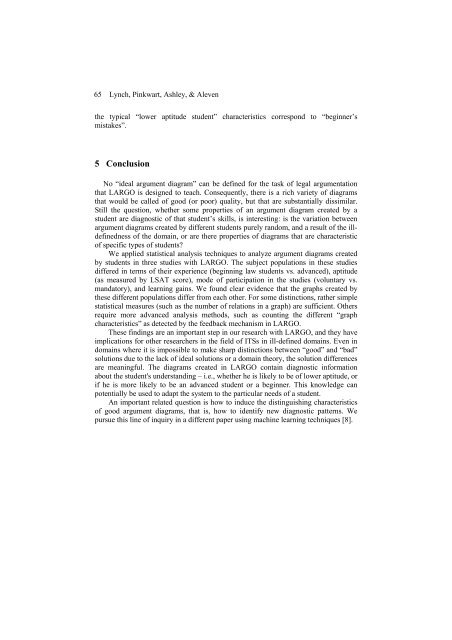Intelligent Tutoring Systems for Ill-Defined Domains - Philippe ...
Intelligent Tutoring Systems for Ill-Defined Domains - Philippe ...
Intelligent Tutoring Systems for Ill-Defined Domains - Philippe ...
Create successful ePaper yourself
Turn your PDF publications into a flip-book with our unique Google optimized e-Paper software.
65 Lynch, Pinkwart, Ashley, & Aleven<br />
the typical “lower aptitude student” characteristics correspond to “beginner’s<br />
mistakes”.<br />
5 Conclusion<br />
No “ideal argument diagram” can be defined <strong>for</strong> the task of legal argumentation<br />
that LARGO is designed to teach. Consequently, there is a rich variety of diagrams<br />
that would be called of good (or poor) quality, but that are substantially dissimilar.<br />
Still the question, whether some properties of an argument diagram created by a<br />
student are diagnostic of that student’s skills, is interesting: is the variation between<br />
argument diagrams created by different students purely random, and a result of the illdefinedness<br />
of the domain, or are there properties of diagrams that are characteristic<br />
of specific types of students?<br />
We applied statistical analysis techniques to analyze argument diagrams created<br />
by students in three studies with LARGO. The subject populations in these studies<br />
differed in terms of their experience (beginning law students vs. advanced), aptitude<br />
(as measured by LSAT score), mode of participation in the studies (voluntary vs.<br />
mandatory), and learning gains. We found clear evidence that the graphs created by<br />
these different populations differ from each other. For some distinctions, rather simple<br />
statistical measures (such as the number of relations in a graph) are sufficient. Others<br />
require more advanced analysis methods, such as counting the different “graph<br />
characteristics” as detected by the feedback mechanism in LARGO.<br />
These findings are an important step in our research with LARGO, and they have<br />
implications <strong>for</strong> other researchers in the field of ITSs in ill-defined domains. Even in<br />
domains where it is impossible to make sharp distinctions between “good” and “bad”<br />
solutions due to the lack of ideal solutions or a domain theory, the solution differences<br />
are meaningful. The diagrams created in LARGO contain diagnostic in<strong>for</strong>mation<br />
about the student's understanding – i.e., whether he is likely to be of lower aptitude, or<br />
if he is more likely to be an advanced student or a beginner. This knowledge can<br />
potentially be used to adapt the system to the particular needs of a student.<br />
An important related question is how to induce the distinguishing characteristics<br />
of good argument diagrams, that is, how to identify new diagnostic patterns. We<br />
pursue this line of inquiry in a different paper using machine learning techniques [8].


